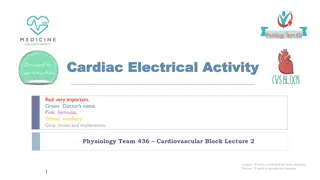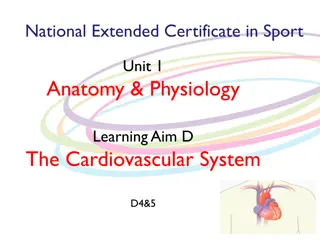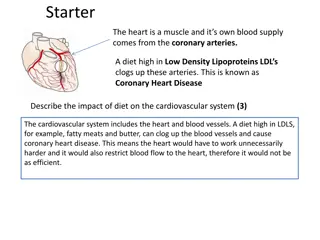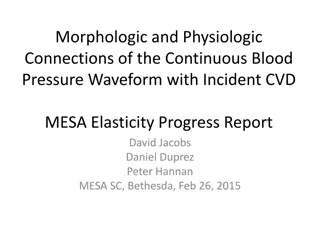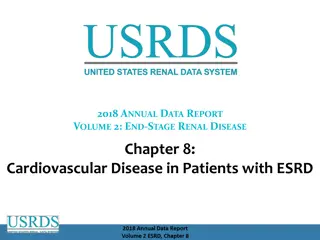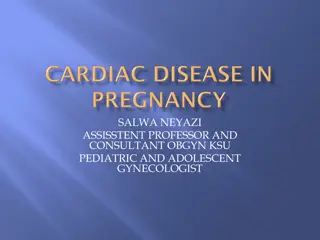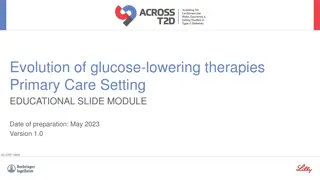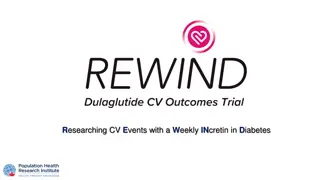Understanding the Cardiovascular System: Anatomy, Physiology, and Function
Explore the intricate workings of the cardiovascular system, encompassing the heart, blood vessels, and blood circulation. Learn the anatomy, physiology, and function of this vital system, including the roles of arteries, veins, capillaries, and red and blue blood. Understand how the cardiovascular system sustains organ health by delivering oxygen and nutrients while removing waste products.
Download Presentation

Please find below an Image/Link to download the presentation.
The content on the website is provided AS IS for your information and personal use only. It may not be sold, licensed, or shared on other websites without obtaining consent from the author. Download presentation by click this link. If you encounter any issues during the download, it is possible that the publisher has removed the file from their server.
E N D
Presentation Transcript
The Cardiovascular (or CV) System Anna H. Haro, Pharm.D. Westside High School March 2022
LEARNING Objectives TEKS: 130.233.(c)(1)(A, & B) and 130.233.(c)(2)(A, B, C, F, & G) & (3)(B) and 130.231.(c)(1)(A, & B) and 130.231.(c)(2)(A, B, C, F, & G) & (3)(B) Students will apply prior knowledge and skills from Biology to develop new knowledge and skills of the Cardiovascular System. Students will develop/recall medical terminology of the Cardiovascular System. Students will explain the physiology of the Cardiovascular System. Students will identify the anatomy of the CV System. Students will describe physiologic traits of blue and red blood.
Objetivos de aprendizaje TEKS: 130.233.(c)(1)(A, & B) and 130.233.(c)(2)(A, B, C, F, & G) & (3)(B) and 130.231.(c)(1)(A, & B) and 130.231.(c)(2)(A, B, C, F, & G) & (3)(B) Los estudiantes aplicar n conocimientos y habilidades previos de biolog a para desarrollar nuevos conocimientos y habilidades del sistema cardiovascular. Los estudiantes desarrollar n/recordar n la terminolog a m dica del sistema cardiovascular. Los estudiantes explicar n la fisiolog a del Sistema Cardiovascular. Los estudiantes identificar n la anatom a del Sistema CV. Los estudiantes describir n los rasgos fisiol gicos de la sangre azul y roja.
Outline cardiovascular system Define Cardio and Vascular Identify the basic physiology or function of the Cardiovascular System Identify the anatomy, including the 4 major vessels of the heart Compare and contrast arteries, veins, and capillaries Explain the differences between blue and red blood
Esquema - sistema cardiovascular Definir Cardio y Vascular Identificar la fisiolog a o funci n b sica del Sistema Cardiovascular Identificar la anatom a, incluidos los 4 vasos principales del coraz n. Comparar y contrastar arterias, venas y capilares. Explicar las diferencias entre sangre azul y roja.
Define Cardiovascular Cardio means _______________. Vascular means relating to the vessels. The Cardiovascular System refers to the system in the body that contains the heart and the blood vessels, also known as the __________________ System.
Physiology of the Cardiovascular System The main function of the cardiovascular system is to circulate blood throughout the body. The heart collects and pumps the blood. The blood vessels deliver blood and O2 to vital organs and other parts of the body, and they remove waste products from the body. Why do organs need circulating blood?
4 major vessels of the heart Memorize the 4 main vessels or chambers of the heart: 2 atria (this is where blood is collected): right atrium and left atrium 2 ventricles (this is where blood is pumped out): right ventricle and left ventricle
Anatomy of the heart Right atrium Aorta Right ventricle Superior Vena Cava Left atrium Mitral Valve Left ventricle Aortic Valve Tricuspid valve Inferior Vena Cava Pulmonary valve Pulmonary artery and Pulmonary vein
Anatomy of the Heart Image accessed here: https://images.app.go o.gl/ER6X1SW8aV7P4ct K8 https://upload.wikime dia.org/wikipedia/com mons/e/e5/Diagram_o f_the_human_heart_%2 8cropped%29.svg
The 4 Heart Valves (memorize these also) The heart valves regulate the direction and flow of blood through the heart and lungs. They prevent the blood from flowing backward in the heart. Through a series of heart beats (contracting and relaxing of the heart) different valves open and close to allow for the proper flow of blood. The tricuspid valve: is located between the right atrium and the right ventricle. The pulmonary valve: is located between the right ventricle and the pulmonary artery. The mitral valve: is located between the left atrium and the left ventricle The aortic valve: is located between the left ventricle and the aorta.
Anatomy of the 4 Heart Valves image from: https://www.texasheart.org/heart-health/heart- information-center/topics/the-heart-valves/
Huh? Diastole and systole? Diastole is the state when the heart is relaxing or filling with blood. Systole is the state when the heart is pumping and expelling blood. Discussion Question 1: During which state, diastole or systole, is the blood pressure higher? Discussion Question 2: During which state, diastole or systole is the heart muscle contracting?
Physiology: Arteries, Veins, and Capillaries Arteries are the blood vessels that carry blood away from the heart. Veins are the blood vessels that deliver blood back to the heart. Capillaries are tiny blood vessels that ______________. Note: When we use the term blood pressure, this refers to the pressure that is exerted against the walls of the blood vessels. If a patient takes a drug that constricts the blood vessels (such as cocaine, a stimulant) , then the blood pressure will ________________. Discuss: What are other example stimulants commonly used daily?
Physiology of the CV System: The function of BLOOD Blood carries oxygen to the muscles and major organs of the body. Blood removes CO2 or ___________ from circulation through a process called _________________. Blood carries nutrients to cells, such as electrolytes, vitamins, and minerals. What are some examples of electrolytes? Circulating blood helps removes other waste products.
BLOOD Physiology Waste products (from metabolism) are carried in the blood to the organs of the excretory and digestive systems to be ________________ from the body. Blood contains immune substances to protect the body from disease and infection. Blood contains clotting factors to protect the body after injury.
Blue blood vs. red blood There are 3 main types of blood cells: Red blood cells (RBC) carry oxygen and CO2. Also called erythrocytes. White blood cells (WBC) help fight infection. They are quite large in comparison to RBC, and are also called leukocytes. Platelets or thrombocytes help form clots to prevent _____________ after injury.
Blue blood vs. red blood Oxygenated blood, or blood rich in oxygen in red in color, is due to the iron-rich hemoglobin molecules. In our red blood cells, (RBC) each cell contains approximately 250 to 270 million hemoglobin molecules, and each of those contains four heme-binding sites for oxygen. Deoxygenated blood is blood that lacks __________________________. Deoxygenated blood is carried back to the right atrium of the heart, where it is then pumped to the lungs to collect oxygen.
Blood circulation memorize this pattern Circulation basics: blood travels from the body to heart to lungs to heart to body and repeats. Step 1. From the body through the inferior or superior vena cave and into the right atrium. This is deoxygenated blood. What does deoxygenated mean? 2. From the right atrium through the tricuspid valve into the right ventricle. Is this blood red or blue? 3. Pumped from the right ventricle through the pulmonary valve to the pulmonary artery into the lungs. Is this blood oxygenated or deoxygenated?
Blood circulation memorize this pattern Circulation basics: blood travels from the body to the heart to lungs to heart to body and repeats. 4. Continued: From the lungs through the pulmonary vein into the left atrium. What is unique about the pulmonary vein? 5. From the left atrium through the mitral valve into the left ventricle. Is this blood red or blue? 6. Pumped from the left ventricle through the aortic valve to the aorta. 7. Out of the aorta to the rest of the body. Is this blood oxygenated or deoxygenated?
Blood flow of oxygenated (red) blood and deoxygenated (blue) blood https://upload.wikimedia.org /wikipedia/commons/e/e5/Di agram_of_the_human_heart_ %28cropped%29.svg
Questions Please email me or visit South 114 during tutorials: 2ndhalf of lunch on Tuesdays, Thursdays, or Fridays. Anna.Haro@houstonisd.org
Text references from: Shier, D., Butler, J., Lewis, R., & Hole, J. W. (2002). Hole's Human Anatomy and Physiology (9th ed.). McGraw-Hill. Images referenced on each applicable slide. References Additional information on the heart and CV System can be found here: https://www.mayoclinic.org/diseases- conditions/heart- disease/multimedia/circulatory-system/vid- 20084745#:~:text=Your%20heart%20is%20a%20pu mp,and%20oxygen%20around%20your%20body.







